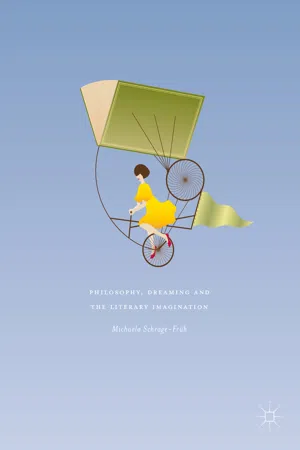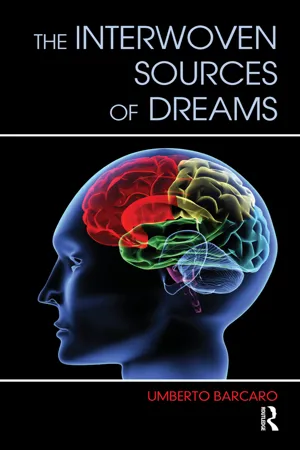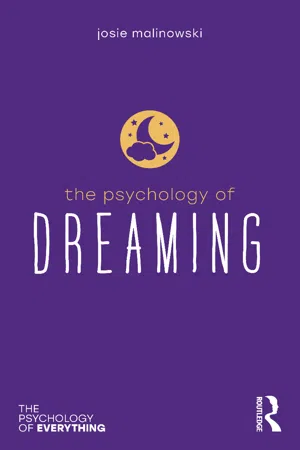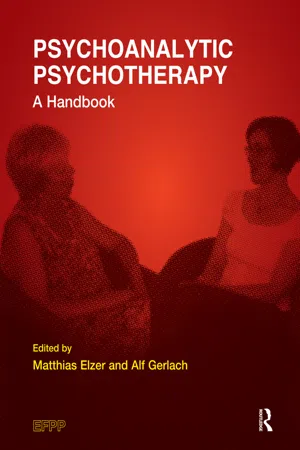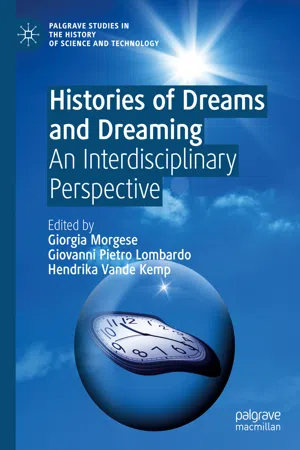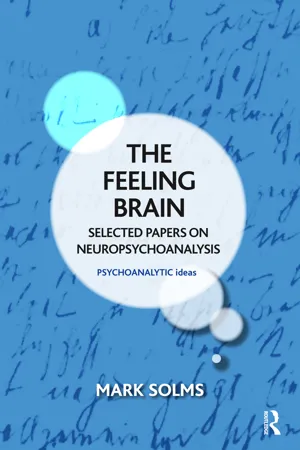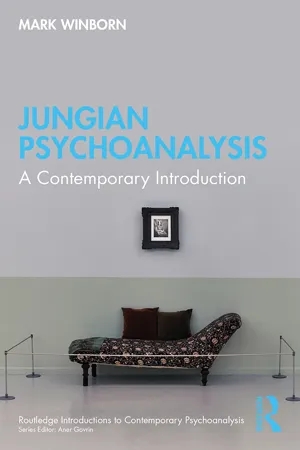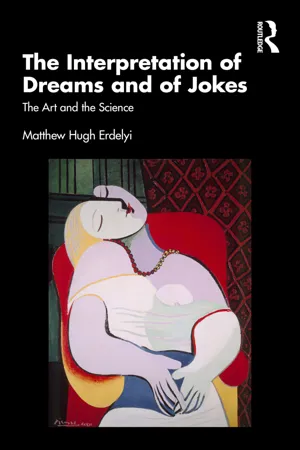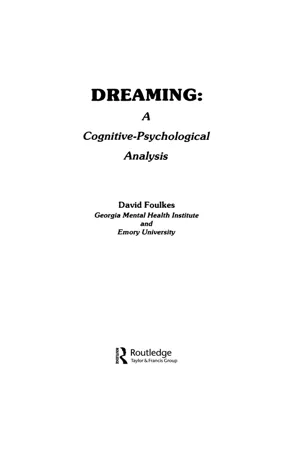Psychology
Theories of Dreams
Theories of dreams in psychology encompass various perspectives on the purpose and meaning of dreams. These theories include Freud's psychoanalytic theory, which suggests that dreams are a window into the unconscious mind, as well as the activation-synthesis theory, which proposes that dreams are a result of random neural activity. Other theories explore the cognitive and emotional functions of dreaming.
Written by Perlego with AI-assistance
Related key terms
12 Key excerpts on "Theories of Dreams"
- Michaela Schrage-Früh(Author)
- 2016(Publication Date)
- Palgrave Macmillan(Publisher)
2In fact, Mary Arnold-Forster (1861–1951) noted as early as 1921: ‘The principles laid down by Freud […] have been so unhesitatingly accepted that anyone who should question their universal applicability would find himself in a small minority, for the modern school of psycho-analysis that is based on Freud’s teaching has an immense vogue.’3 Even today, there basically seems no way around Freud’s Traumdeutung , which is why even a study emphatically not employing a Freudian approach first needs to clarify why certain of Freud’s hypotheses no longer hold. In order to do so, I will first briefly outline Freud’s concept of the ‘dream work’ and then assess it in light of the findings of neurocognitive and empirical dream research that inform my own approach.The idea that the interpretation of dreams is, above all, ‘the royal road to a knowledge of the unconscious activities of the mind’,4 as Freud so famously put it, resulted in the fact that dreams were mostly regarded as a means to an end, the psychotherapist’s entrance into the patient’s submerged world of childhood experiences and repressed infantile desires and drives. Dreams, in this theory, are viewed as ‘wishfulfilling hallucinations’.5 According to Freud, what mattered was not so much what happened ostensibly in the dream, but rather the buried truths that could be excavated through careful interpretation and associative analysis of the dream symbols. This is why he differentiated between the manifest dream content (the dream as we remember and report it) and the latent dream thoughts (that could only be revealed psychoanalytically by means of free association). What Freud called the ‘dream work’ worked like this: during sleep, our unfulfilled, often libidinal wishes, usually repressed by our ego, threaten to invade consciousness and disturb sleep. In order to guard our sleep, a repressive censorship mechanism disguises these possibly disturbing desires as ostensibly harmless bits of daytime residue. Our wishes are thus secretly fulfilled without disturbing our sleep or destroying our respectable self-image. As Freud himself puts it, ‘the content of a dream is the representation of a fulfilled wish and […] its obscurity is due to alterations in repressed material made by the censorship’.6 These ‘alterations in repressed material’ are achieved through the dream work, ‘the process by which the latent content of a dream (its original, undisguised text) is translated into its manifest content (the text as actually remembered and reported by the dreamer)’.7 Its most important tools are displacement, symbol formation, condensation and secondary revision, the latter of which turns ‘a sequence of discrete disguise-images’ into a more or less coherent narrative.8- eBook - ePub
Sleep Disorders
Elements, History, Treatments, and Research
- Kathleen J. Sexton-Radek Ph.D., Gina Graci(Authors)
- 2021(Publication Date)
- Praeger(Publisher)
CHAPTER 10 Dreaming as a Psychological ProcessW hy do we dream, why are some dreams frightening, and why do we only remember some of our dreams? Hypotheses have abounded for years regarding the meaning and biological or neurological pathway of dreams. Some people earn a living by analyzing dreams, but what do dreams really mean, and what is the current dream landscape? The symbolic meaning of dreams is called the latent content of dreams, and many people believe there are hidden messages in dreams. Some scientists believe that dreaming is related to depression, and some therapists postulate that if the unconscious meaning of dreams can be interpreted, then psychological distress could be relieved (Cherry, 2020). This chapter will explore dreaming as a psychological process.A dream is defined as a physiologically and psychologically conscious state that occurs during sleep. It is often characterized by a rich array of endogenous sensory, motor, emotional, and other experiences (American Psychological Association [APA], 2020). Dreams mainly occur in rapid eye movement (REM) sleep and may be logical or illogical. Dream interpretation is the attempt at finding meaning from dreams as it applies to an individual’s life.Sigmund Freud believed that the meaning and content of dreams were heavily encrypted and hard to translate (Lyon, 1990). The hidden meaning of dreams played an important role in Freud’s psychoanalytic theory, and he believed that bringing the hidden meaning of a dream into conscious awareness could relieve psychological distress (Freud, 1913). For instance, Freud believed that the latent content of a dream was not only suppressed but hidden by the subconscious mind to protect the person from thoughts and feelings that were hard to cope with (Cherry, 2020).While the function of sleep is hypothezied to be based on restorative properties, there is no concluding evidence that this is true. The early work of Dr. Rosalind Cartwright (the Grandmother of Sleep) showed the scientific measurement of sleep and dreaming, primarily dreams and the process of dreaming. “Dreams,” wrote Cartwright, “are our private perceptions which cannot be validated or shared by others” (Cartwright, 1977). She also postulated that dreams may “provide us with a direct cure for certain mental problems long before anyone determines exactly what sleep and dreaming are for” (Lyon, 1990). - eBook - ePub
- Umberto Barcaro(Author)
- 2018(Publication Date)
- Routledge(Publisher)
A first motivation for this poor interest is, according to the authors, the preference of cognitive psychologists for phenomena characterized by intrinsic organization and rationality, while “dreaming seems so puzzling and messy a thing” (p. 1).A second motivation, conceptually close to the first, is that dreaming appears as a phenomenon difficult to be controlled by the experimenter. In other words, assuming the point of view of computer science, which is important as a reference paradigm for cognitive psychology, it seems hard to establish clear and certain relationships between the input and the output of the dreaming process.Then the authors add a third motivation which is historical and psychological at the same time: cognitive psychologists have accepted the idea that two other disciplines, and not proper psychology, are appropriate for the study of dreaming: psychoanalysis and psychophysiology. “Most cognitive psychologists are not at all familiar with either of these disciplines, and the study of dreaming therefore seemed outside their professional bounds” (p. 2). The authors claim that it is a mistake to consider dreaming as a subject reserved to Psychoanalysis or to Psychophysiology.With regard to Psychoanalysis, the authors consider its criteria for dream interpretation lacking of any scientific and empiric support, but, at the same time, they underline the aspects of the Freudian method which are important from the viewpoint of cognitive psychology. In fact, Freud implicitly considers the reported dream as the output of the dream processing system, and the Freudian method of free associations allows identifying the input, consisting of specific memories.The authors then examine the idea, stated by many physiologists, that dreams occur only during REM sleep, that is, the sleep stage characterized by Rapid Eye Movements (a topic which we will consider later). They do not agree that the study of REM sleep and of its relationship with dreaming implies that purely neurobiological means are able to explain the phenomenon of dreaming. First of all, they state that the equation equalling REM sleep to dreaming is wrong, because: a) REM sleep epochs exist without dreaming; and b) dreaming exists in sleep stages different from REM sleep. They add that lab studies on dreams evidence the need of a psychological and not physiological, more precisely a cognitive-psychological, explanation. They underline that, according to the results obtained by the analysis of dream reports elicited after forced awakening in the lab, “dreamlife is surprisingly mundane” and this suggests that a remarkable continuity exists between dream mentation and wakefulness mentation. We have already discussed this important idea of continuity in Section [Other possible dream sources outside the mind of the dreamer: Subliminal stimuli (26)], while considering the model of the dreaming system proposed by Fiss. In Section [The generative role played by the metaphor system in dreaming according to Lakoff’s Theory (32)] we mentioned the debate about the validity of lab dreams. - eBook - ePub
- Josie Malinowski(Author)
- 2020(Publication Date)
- Routledge(Publisher)
neurocognitive theory (Domhoff, 2001). This theory emphasised that not only are dreams a form of cognition which embody our concerns from waking life, but that they are only able to form in minds that are mature enough (i.e. the brain has developed enough in childhood to be able to produce dreams), in the absence of brain damage that may affect dreaming (see next section), in the absence of stimuli (i.e. the mind is not engaged with anything else at the time), and with the correct activation of certain brain regions. Dreaming, in this formulation, draws on our memories, our understandings of ourselves and our world, and our imaginations, to create simulations of our reality that depict things we are thinking about and doing in waking life. This theory is the first we have considered so far to place dreams firmly in the physical stuff of the brain (as opposed to the abstract, formless ‘mind’), and it’s to this that we turn in the next section.INTO THE 21ST CENTURY: NEUROSCIENCE
Neuroscientific oneirology aims to discover what is going on behind the scenes, in our brains, when we dream. When rapid eye movement (REM) sleep was discovered in 1953, there followed a flurry of excitement amongst sleep and dream researchers. For some time, it was thought that REM sleep and dreaming were two sides of the same coin: that whenever we are in REM sleep, we are dreaming; and whenever we are dreaming, we are in REM sleep. But, of course, our brains weren’t going to make it that easy for us. We now know it’s far more complicated than this.THE ACTIVATION-SYNTHESIS HYPOTHESIS
One of the most influential (and controversial) neuroscientific theories is the activation-synthesis hypothesis (Hobson & McCarley, 1977). This hypothesis placed itself in direct opposition to traditional psychoanalytical theories of dreaming. It claimed that dreams are not a result of disguised wishes, but rather are the result of the activation of disparate regions of the brain and the synthesis - eBook - ePub
Psychoanalytic Psychotherapy
A Handbook
- Matthias Elzer, Alf Gerlach, Matthias Elzer, Alf Gerlach(Authors)
- 2018(Publication Date)
- Routledge(Publisher)
CHAPTER FOURDREAMS
Joachim Rothhaupt, Stephan HauThe history of the theory of dreaming and dream researchJoachim RothhauptP sychoanalytical dream research is concerned with three main aspects of dreaming:1. How a dream is generated (generation).2. Whether the dream contents are meaningful (meaning).3. Whether a dream works for psychological or biological needs (function).Freud’s dream theoryThe theory introduced by Sigmund Freud at the beginning of the twentieth century can be seen as a turning point in the scientific investigation of dreams. The psychoanalytic dream theory has deeply influenced most of the current clinical theories on dreaming and, to some extent, modern experimental investigation of dream states as well. In the 1950s, the discovery of REM sleep and of the profile of typical different sleeping states during the night provided the starting point for modern sleep and dream research. This laboratory research has revealed overwhelming new knowledge about the dreaming mind and about the features of the dream state. I will come back to this type of research and to some of the most important findings later. Freud’s “main idea was that dreams serve a function of wish fulfilment. He distinguished between a manifest level of dream content (the dream as it is remembered and reported) and a latent level of dream content that can be inferred by following the associations of the dreamer to the single parts of the dream and by tracing back the different steps of dream work in which the material (infantile material, day residues, etc.) is condensed, displaced, or secondarily revised. The underlying assumption is that the associative chains of the dreamer to every part of the dream will lead to the mental processes that gave rise to the dream and thereby reveal the unconscious (latent) meaning of the dream”. (Hau, 2004, p. 1) - eBook - ePub
Histories of Dreams and Dreaming
An Interdisciplinary Perspective
- Giorgia Morgese, Giovanni Pietro Lombardo, Hendrika Vande Kemp, Giorgia Morgese, Giovanni Pietro Lombardo, Hendrika Vande Kemp, Giorgia Morgese, Giovanni Pietro Lombardo, Hendrika Vande Kemp(Authors)
- 2019(Publication Date)
- Palgrave Macmillan(Publisher)
At the same time, these new findings from empirical research challenge the choice of the three scholars Asmar (1999) and Nielsen and Germain (1998) to exclude a priori from their analysis any studies on dreams published before 1960. Probably one can find reasons for these choices in the origins and value that psychoanalysis has assumed at a social and cultural level, as proposed by Rieff (1966), Ellenberger (1970), and Smith (2004). Psychoanalysis, with a sophisticated and at the same time charming style, can provide an answer to the individual’s suffering, taking the place of some systems, like religious systems that had until then provided a secure base of connection between the individual subject and society. At the same time, general psychology, declaring its limit in the unveiling of a part of the consciousness (see Richet 1884) and the advent of behaviorism, as emphasized by Schwartz (2000), has led to obscuring the studies on the dream that this present work highlights. The new findings on approaches that have characterized the process of “secularization” of the dream by the end of the nineteenth century cast an important light on the conclusion of contemporary scholars that the study of dreams was not “scientific” until 1953. In particular, physiological and psychological studies, although based on the tools of human anatomy, were limited by the scientific developments of the time and developed in a period of flourishing and significant discoveries. They have the merit of attempting to localize the brain functions of dreaming and framing it in an integrated perspective in relation to the phenomenon of sleep, analyzing the dreaming event from a qualitative point of view. Lavie and Hobson (1986) showed that in the early years of the eighteenth century it was possible to detect traces of physiological studies of dreams - eBook - ePub
Freud: The Key Ideas
Psychoanalysis, dreams, the unconscious and more
- Ruth Snowden(Author)
- 2017(Publication Date)
- Teach Yourself(Publisher)
4 The interpretation of dreamsIn this chapter you will learn:• why dreams are important in psychoanalysis• about dream mechanisms and methods of interpretation• some Freudian symbols and about the origins of dreams.Why dreams are important in psychoanalysisProbably Freud’s greatest contribution to modern thinking is his theory of the unconscious. The positivism that was popular in Freud’s time claimed that people could gain real knowledge of the world and of themselves, and that we had rational control over both. This sort of attitude was reflected throughout scientific thinking, with its insistence on ‘hard facts’, and it even permeated psychology. Freud began to realize that such claims are, at best, delusions, because we are not always aware of what we really think and we are often motivated by unconscious forces within us. He suggested that consciousness actually existed in layers and that there were many psychic processes that went on below the surface, in the world of the unconscious.Dreams were the most immediate and accessible examples of this kind of unconscious thinking – not only did they prove that the unconscious exists but they also provided a means of accessing the information stored there. Freud’s book, The Interpretation of Dreams, really marks the beginning of psychoanalysis proper, in that it proposes the existence of a dynamic unconscious that begins to form in childhood and affects the behaviour of all of us. It does not, however, live up to its claim that Freud had discovered a scientific method for unravelling the meaning of every dream.People have always been interested in dreams, but before Freud they tended to think that the dream somehow arose from outside the dreamer, often as a message from the gods. Thus, dreams were often seen as omens or portents of things that were going to happen in the future. Another theory was that dreams were simply meaningless images caused by indigestion! There was already a great deal of literature concerning dreams in Freud’s day, but he pulled a whole variety of ideas together. He created the first proper theory of dreams and made them into a respectable topic for scientific study. - eBook - ePub
The Feeling Brain
Selected Papers on Neuropsychoanalysis
- Mark Solms(Author)
- 2018(Publication Date)
- Routledge(Publisher)
NEUROPSYCHOANALYTIC PERSPECTIVES ON DREAMSPassage contains an image
CHAPTER EIGHTFreudian dream theory todayMark SolmsI t is still too soon to reach a definitive verdict on the central tenets of Freud’s dream theory, but recent neuropsychological research suggests that he was at least on the right track.Summary of the theory
Freud (1900a) claimed that dreams were attempts to fulfil peremptory wishes, arising during sleep, derived from appetitive (“libidinal”) urges. He based this claim on findings from a purely subjective method: he collected dreamers’ associations to the individual elements of their dreams and then inferred implicit, underlying themes from the converging semantic and affective links. The “latent” thoughts revealed in this way, Freud observed, were always wishful—notwithstanding the fact that manifest dreams assume a wide variety of forms, some of which appear anything but wishful.The differences between the “manifest” and the “latent” content of dreams led Freud to infer an intervening process, by means of which the unconscious wishes could be transformed into conscious dreams. This intervening process was the so-called dream-work, which involved mechanisms such as “displacement” (substituting representational elements for one another), “condensation” (combining multiple elements into composite hybrids), and “regression” (converting thoughts into perceptions).Why did Freud think the mind functioned in this peculiar way during sleep? He offered a cascade of hypotheses. The sleeping mind is disconnected from external reality, but not from its innate (instinctual) dispositions. These dispositions are unmodulated during sleep by the constraints of external reality. Goal-directed motor activity is impossible during sleep. The motivational programmes that are activated during sleep (and especially the peremptory ones, activated from instinctual sources) cannot be discharged in motor activity during sleep. Instead of acting on one’s wishes during sleep, therefore, one imagines oneself acting on them. This imaginary (hallucinatory) fulfilment of the wish defers the pressure to act. Hence Freud’s claim “that dreams are the guardians of sleep”. - eBook - ePub
Jungian Psychoanalysis
A Contemporary Introduction
- Mark Winborn(Author)
- 2023(Publication Date)
- Routledge(Publisher)
Chapter 5Jungian Perspectives on Dreams
DOI: 10.4324/9781003223511-6Dreams hold a place of prominence within Jungian psychoanalysis and in the curricula of Jungian training programs. Many individuals drawn to practice as Jungian psychoanalysts are initially attracted by the special emphasis Jung placed on dreams. As mentioned earlier, following his split with Freud, Jung began to outline out his model of the psyche, contrasting it with Freud’s model. Jung’s model of dreaming was laid out as a repudiation of Freud’s model and as a repudiation of many elements of Freud’s model of psychic functioning in general. Because of this, despite the many changes in contemporary psychoanalysis since Freud’s death, it remains relevant to discuss Jung’s model of dreaming in contrast to Freud’s model.Jung did not believe the origins of dream content could be solely reduced to infantile, forgotten, or repressed wishes. Following their split, Jung promptly abandoned Freud’s conceptualization of the dream as possessing both manifest and latent contents. Unlike Freud, Jung did not conceive the dream as having a hidden meaning which was disguised to protect the sleep of the dreamer from distressing contents entering the dream unfiltered. Therefore, Jung’s theory of dreaming had no place for a distorting censor which undermined Freud’s fundamental concept of dreamwork, i.e., the distortion process which transforms the hidden latent content of the dream into the manifest content, i.e., the dream as remembered. For Jung, the meaning of a dream was not difficult to understand because of the distorting-disguising effects of the dreamer’s defenses but because the conscious state of the dreamer is not oriented to understanding the symbolic-metaphorical language which dreams speak in. In other words, dreams could be understood if we more fully grasped the language of metaphor and symbol through which dreams are communicated. Interestingly, self psychology, as developed by Heinz Kohut, modifies Freud’s dream theory by placing greater emphasis on the manifest content of a dream, which Kohut conceptualized as communicating the state of the dreamer’s self, i.e., self-state dreams (Mitchell and Black 1995 - eBook - ePub
The Interpretation of Dreams and of Jokes
The Art and the Science
- Matthew Hugh Erdelyi(Author)
- 2022(Publication Date)
- Routledge(Publisher)
7 Overview and ConclusionsDOI: 10.4324/9781003300441-8Dreams Have Meaning, and at More Than One Level
Before getting to first base on dream interpretation, we must first dispense with the question whether dreams actually have meaning; for if dreams were “mere froth” (a common dismissal of dream meaning cited by Freud (1900/1953 , p. 634)), if they were only random, meaningless effusions of the night, there would not be much point in trying to interpret dreams. Nonsense would beget nonsense.But is it not obvious that dreams have meaning? Unfortunately, the smart money has not always been on board on the subject. Already, as we saw in Chapter 1 (pp. 13–14), Cicero, some two millennia ago, in his “Argument Against Taking Dreams Seriously,” was dismissive of the subject and disdained the “divination of dreams” as superstition and subject to “endless imbecilities.” Academic psychology has been more circumspect in language but not much more encouraging conceptually. For several decades the impression has been given—it would be instructive to examine some of the leading introductory textbooks of psychology—that dreams are really random forms of cognition and so, one could conclude, meaningless noise. The focus has been on the neuroscience of sleep and dreaming, but not on the meaning of dreams. Astonishingly, more than half a century after the much ballyhooed cognitive revolution against behaviorism, cognitive psychology textbooks altogether avoid the subject of dreams, let alone the meaning of dreams, even though the phenomena of dreams intersect virtually all major topics of modern cognitive psychology. The flagship journals of psychology are similarly MIA on the subject.Probably a part of the puzzle is Hobson and McCarley’s extraordinarily influential 1977 publication of their activation-synthesis hypothesis, which was a neuroscience model of dreaming that provided an alternative to Freud’s psychological approach. REM sleep, which at the time was thought to be coterminous with dreaming, was not, according to the activation-synthesis model, provoked by wishes but by the cyclic activation, several times a night, of random firings from the pontine hindbrain (see our Chapter 4 ) that fanned outward to other regions, including frontal areas responsible for high-level cognition, where a synthesis of the incoming stimuli was attempted. Since some of the frontal brain areas involved in the highest levels of cognition (notably, the dorsolateral prefrontal cortex; see our Chapter 4 ) are substantially inhibited during dreaming, the debilitated frontal brain has to do “the best of a bad job” (Hobson, 2011 - eBook - ePub
Dreaming
A Cognitive-psychological Analysis
- David Foulkes(Author)
- 2014(Publication Date)
- Routledge(Publisher)
1 What Dreams AreDespite widespread disagreement on how to interpret dreams, there has been general agreement, at least since the publication of Freud’s The Interpretation of Dreams,1 about what dreams are.1. Dreams are Involuntary Symbolic ActsOne of Freud’s major theses about dreaming was that dreams are a form of thought or symbolic activity. The major question of his book was why we think in a different way when we are asleep than we do when we are awake. This is still the central concern of dream psychology. One dimension of difference between dreams and at least some of our waking symbolic behavior is that dreams are involuntary. That is, we are generally surprised on awakening from a dream because we didn’t consciously will that we would dream it. If you think of our waking speech, we generally end up saying something that bears some relationship to what we wantedto say. But dreaming generally doesn’t seem to express any coherent set of wishes or wants at all. At least, we’re generally unable, after having dreamed, to figure out why we dreamed what we did, or what, if anything, we meant to express or establish by having dreamed it.But involuntary ideation is by no means foreign to our waking experience. In fact, in implicitly taking problem solving or reasoning as our model of what waking thought typically is like, we probably greatly over-estimate the voluntary control that we exert over the flow of conscious waking ideation. Often, when we are not occupied with the demands of reality—and sometimes even when we are—unbidden thoughts and images “pop into” consciousness. And, although we may be momentarily bemused or astonished by these thoughts and images, we don’t seriously doubt that we somehow conjured them up. They are our - eBook - ePub
- Erich Fromm(Author)
- 2013(Publication Date)
- Open Road Media(Publisher)
Freud assumed that all dreams are essentially fulfillments of wishes and have the function of preserving our sleep by, as it were, hallucinatory fulfillment. After fifty years of interpreting dreams I must confess that I find this principle of Freud’s only of limited validity. Undoubtedly he made a great discovery when he recognized that dreams are very often the symbolic satisfaction of wishes. But he damaged the significance of this discovery by the dogmatic assumption that this necessarily holds true for all dreams. Dreams can be wish fulfillments, dreams can express mere anxiety, but dreams can also—and this is the important point—express deep insights into oneself and into others. In order to appreciate this function of dreams, some consideration concerning the difference between the biological and psychological functions of sleeping and waking may be useful (see also Fromm, 1951a, chapter 3).In the waking state thoughts and feelings respond primarily to challenge—the task of mastering our environment, changing it, defending ourselves against it. Survival is the task of waking man; he is subject to the laws that govern reality. This means that he has to think in terms of time and space.While we sleep we are not concerned with bending the outside world to our purposes. We are helpless, and sleep, therefore, has rightly been called the “brother of death.” But we are also free, freer than when awake. We are free from the burden of work, from the task of attack or defense, from watching and mastering reality. We need not look at the outside world; we look at our inner world, are concerned exclusively with ourselves. When asleep we may be likened to a fetus or a corpse; we may also be likened to angels, who are not subject to the laws of “reality.” In sleep the realm of necessity has given way to the realm of freedom in which “I am” is the only system to which thoughts and feelings refer.Mental activity during sleep has a logic different from that of waking existence. As indicated before, sleep experience need not pay any attention to qualities that matter only when one copes with reality. If I feel, for instance, that a person is a coward, I may dream that he changed from a man into a chicken. This change makes sense in terms of what I feel about the person, not in terms of my orientation to outside reality.
Index pages curate the most relevant extracts from our library of academic textbooks. They’ve been created using an in-house natural language model (NLM), each adding context and meaning to key research topics.
